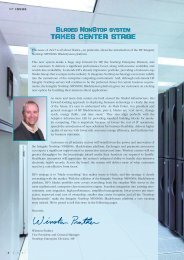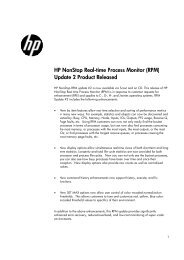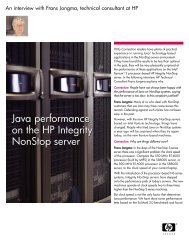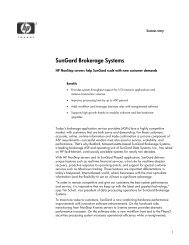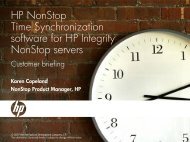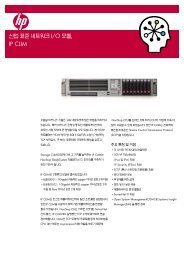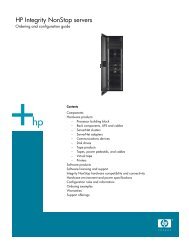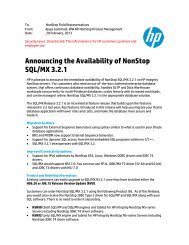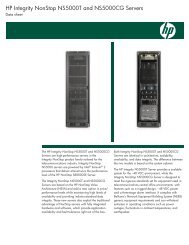the business case for a zero latency enterprise - HP NonStop
the business case for a zero latency enterprise - HP NonStop
the business case for a zero latency enterprise - HP NonStop
Create successful ePaper yourself
Turn your PDF publications into a flip-book with our unique Google optimized e-Paper software.
EAI technologies have traditionally been limited in terms of scalability. Thus <strong>the</strong>y havebeen unable to handle <strong>the</strong> large event volumes that characterize a ZLE environment.EAI toolsets have also typically lacked <strong>the</strong> robust transactional and message storecapabilities required by a <strong>zero</strong> <strong>latency</strong> <strong>enterprise</strong>.Traditional data warehousing is normally implemented using high-<strong>latency</strong> (batch)extraction, trans<strong>for</strong>mation, and load (ETL) technology. Fur<strong>the</strong>rmore, it is focused onsummarizing historical data ra<strong>the</strong>r than providing real-time operational views. A datawarehouse is not typically equipped to handle high-volume data access and <strong>the</strong>concurrent mixed workloads (simultaneous real-time updates, time-critical transactions,and complex querying) that characterize a ZLE environment.The ZLE architecture has to fill those technology gaps by augmenting <strong>the</strong> applicationintegration capabilities of EAI with high-volume event capture, message trans<strong>for</strong>mationand routing, and <strong>business</strong> rules functionality. And it must enhance <strong>the</strong> data integrationstrengths of traditional data warehousing with real-time data caching, messagemanagement, and concurrent mixed-workload capabilities.providing a solid operational plat<strong>for</strong>mGoing beyond traditional EAI and database limitations is <strong>the</strong> functional challenge ofdeveloping a ZLE architecture. There is also <strong>the</strong> operational challenge of providing amassively scalable, 24 x 7 base <strong>for</strong> ZLE operations. ZLE is by nature operational.Once <strong>the</strong> architecture is implemented, with scores of systems depending on itsoperations, it is imperative that nothing halt or compromise <strong>the</strong> real-time flow oftransactions and messages⎯not even <strong>for</strong> a second.meeting <strong>the</strong> challenge: <strong>the</strong> hp ZLE frameworkThe <strong>HP</strong> ZLE framework (see figure 1) provides a unifying architecture <strong>for</strong> integrating,synchronizing, routing, caching, and per<strong>for</strong>ming transactions in real time. It eliminates<strong>enterprise</strong> <strong>latency</strong> and, at any given moment, provides a single, consolidated, and upto-<strong>the</strong>-secondview of all pertinent data from all <strong>the</strong> disparate applications it integrates.The <strong>HP</strong> ZLE framework provides a high-level architecture <strong>for</strong> existing systemenvironments and integrates with <strong>the</strong>m seamlessly and noninvasively. Enterpriseapplications such as CRM and <strong>enterprise</strong> resource planning (ERP) are attached to <strong>the</strong>ZLE framework with industry-standard EAI technologies, including application andtechnology adapters. Third-party EAI solutions from vendors such as SeeBeyond,TIBCO, and webMethods can also integrate with <strong>the</strong> ZLE framework. In<strong>for</strong>mation from<strong>the</strong>se applications and independent solutions is consolidated and cached at <strong>the</strong> logicalcenter of <strong>the</strong> framework—a virtual hub called <strong>the</strong> ZLE core.3



